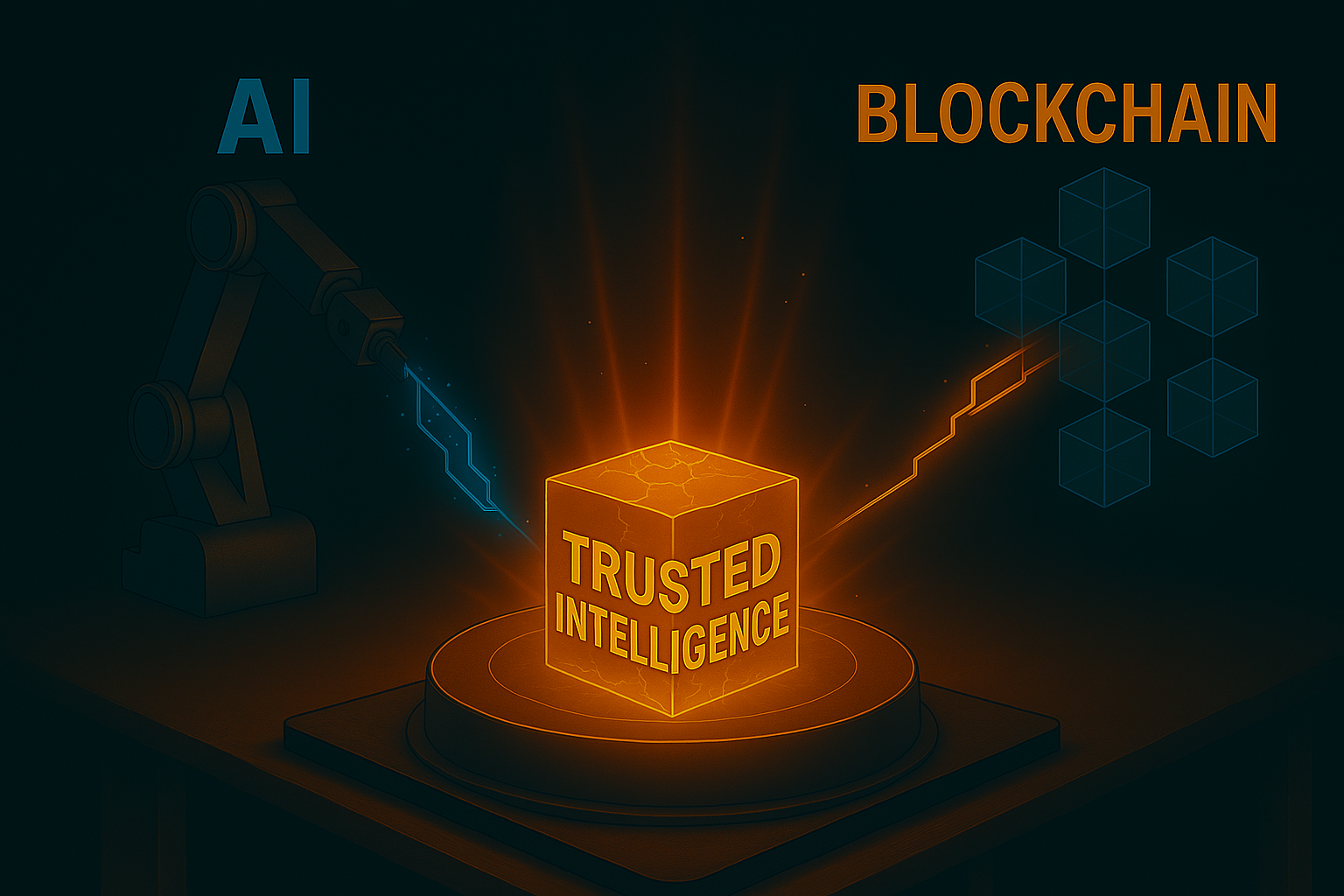AI + Blockchain = Trusted Intelligence: Part 2

Welcome back. This is the second in a series of blogs responding to a16z’s recent position paper on the intersection of AI and Blockchain.
Our first blog covered Persistent data and context in AI interactions, Universal Identity for AI Agents, and Forwards-compatible proof of personhood. In today’s installment we look at how AI and blockchain might shape the development of Decentralized Physical Infrastructure (DePIN), infrastructure in common and standards for AI agents, mechanisms to keep AI/vibe-coded apps in sync, and infrastructure that facilitates micropayments for revenue sharing.
These are ‘big picture’ topics that will have sweeping implications for business, government, and individual people. This hybrid intersection of AI + blockchain technology is coming together quickly and requires us to think carefully about laying the groundwork for a fair, prosperous new era.
Section 4: Decentralized Physical Infrastructure (DePIN) for AIAI’s growth is limited by access to compute and energy, but DePIN networks allow communities to pool unused hardware and power, creating open, permissionless compute marketplaces. This decentralized model reduces costs, increases resilience, and resists censorship — offering a scalable alternative to hyperscaler-controlled infrastructure.
How IronWeave can add value:
IronWeave’s architecture can serve as the secure backbone for DePIN networks, enabling trusted coordination across diverse contributors of compute, storage, and power resources. Its modular encryption and decentralized consensus framework allow:
- Immutable proof of contribution - ensuring that compute nodes and power providers are fairly credited and compensated without needing to trust a central operator, and without having to reveal to public scanners or interlopers how much they have contributed, or the compute they have engaged in.
- Programmable, transparent rewards - can be used to privately and securely manage incentives and validate usage data. This enables automated payments and reputation tracking without exposing the service provider or the customer to front-runners, data scrapers, or bad actors.
- Censorship-resistance and resilience - IronWeave’s extensible fabric-based design ensures no single node can disrupt the network, supporting horizontal scalability and true permissionless participation.
Where hyperscaler control introduces bottlenecks and vulnerabilities, IronWeave reinforces DePIN’s promise of open, federated infrastructure for AI development without putting participants at risk of fraud, abuse, or data exposure.
Section 5: Infrastructure and guardrails for interactions between AI agents, end-service providers, and usersAs AI agents begin operating independently and collaborating with other agents, we’ll need shared infrastructure and protocols to standardize interactions, ensure intent alignment, and enable secure agent-to-agent transactions. Blockchains can provide the decentralized, interoperable foundation for these systems, with some early platforms already emerging.
How IronWeave adds value:
IronWeave enables secure, verifiable, and auditable AI-to-AI and AI-to-human interactions by acting as a private and decentralized coordination layer. Key functions:
- Identity and access control — each agent, service provider, and user can be assigned a cryptographically secure and unique identity on IronWeave, ensuring provenance and accountability. This identity can manifest as an independent chain in IronWeave, providing a vast array of flexibility, extensibility, verifiability, and audit or activity controls. This framework ensures and confirms AI agents are doing what they should, and with whom, but no more. And all such data for interactions can be kept on-chain, for security and validation reasons. No offloading required.
- Intent alignment and contract enforcement — programmable contracts can encode behavioral guardrails and enforce compliance without intermediaries.
- Encrypted, traceable messaging — all agent interactions are privately recorded and verifiable through IronWeave’s tamper-resistant shared blocks, each uniquely hashed and available only to the agent owners, enabling immutable oversight and dispute resolution.
In short, IronWeave provides the trust framework that autonomous agent ecosystems need to scale safely and interoperably.
Section 6: Keeping AI/vibe-coded apps in sync The rise of AI-generated software brings customization and speed, but also fragmentation and compatibility issues across applications. Blockchain-based synchrony layers can standardize and update software connections in real time, while also incentivizing their maintenance - helping a fast-evolving ecosystem of AI-generated tools stay stable and interoperable.
How IronWeave adds value:
IronWeave’s modular, app-specific chains and dynamic upgrade mechanisms make it ideal for coordinating a rapidly evolving ecosystem of AI-generated applications:
- Version control with immutability - software versions, dependencies, and update histories can be tracked immutably per-chain (application or module) basis.
- Sync layers and compatibility protocols - IronWeave can host decentralized registries that standardize how apps interoperate and update over time, minimizing fragmentation. Since a fabric is data + services, and the data on IronWeave is both flexible and programmable, the ability to create and provide services in the IronWeave ecosystem is limited only by creativity and innovation… not limited by scale or storage or performance.
- Incentivized upkeep - devs and maintainers can be rewarded for maintaining compatibility and updating APIs through IronWeave’s micropayment and incentive infrastructure.
As AI pushes software toward constant regeneration, IronWeave ensures the resulting ecosystem stays coherent, reliable, and user-friendly.
Section 7: Micropayments that support revenue sharingAI tools are disrupting the web’s economic model by diverting attention and value from original content creators, risking a more closed and paywalled internet. Blockchain-based micropayment infrastructure can enable fine-grained, automated revenue sharing across contributors through nanopayments, programmable contracts, and payment splits, aligning incentives and preserving an open digital ecosystem.
How IronWeave adds value:
IronWeave is built from the ground up to support the scalable, transparent, and programmable micropayment systems that AI-era economies will demand. It solves the performance, attribution, and trust problems that plague existing web monetization schemes, including slow and expensive existing-blockchain payment systems:
🔹 Scalable Nanopayments Across Contributors
IronWeave supports ultra-low-fee transactions at massive scale, making it feasible to split a single payment across dozens-or hundreds or even more - of data or content contributors. Each interaction can trigger revenue splits, with payments executed in real time or on programmable schedules.
🔹 Customizable Payment Logic Per App or Dataset
IronWeave’s flexible block and independent chain structure allows payment logic to be tailored to each app, user account, or dataset. For example, a research contributor to a training corpus could define revenue-share terms that apply only when their data is used in commercial inference-and enforce that based on programmable contract language.
🔹 Immutable Attribution Trails
Because IronWeave records provenance data immutably, it becomes possible for chains to be created that can attribute value to original contributors. When an AI-generated output results in a transaction or subscription, for example, IronWeave can immutably link that outcome to the provenance of upstream data sources, and distribute pre-defined compensation accordingly.
🔹 Private by Default, Transparent When Needed
Where attribution requires transparency, IronWeave enables owners to reveal it. But where privacy is necessary-such as when contributors don't want their identities or raw data revealed-IronWeave ensures that only required data, hashes, and signatures are used to verify participation and trigger payment, without exposing sensitive or private details.
In sum, IronWeave creates the infrastructure for fair, programmable, massively scalable, privacy-respecting monetization of digital content and data in an AI-native internet. It rebalances power away from centralized aggregators and back toward the individuals and teams who create the value in the first place.
We believe these are each important and compelling topics to consider when thinking about which infrastructure is ready to carry the load of an AI + blockchain centric online world. It’s crucial that we design and solve these issues in a way that gives the greatest benefit to the greatest number of people.
In our third and final installment we will discuss:
- blockchain as a registry for intellectual property and provenance
- AI powered web crawlers as economic agents for content creators
- privacy preserving digital ads, and
- AI companions owned and controlled by humans
We hope you’ll join us as we continue to think about the implications of these fast evolving technologies
